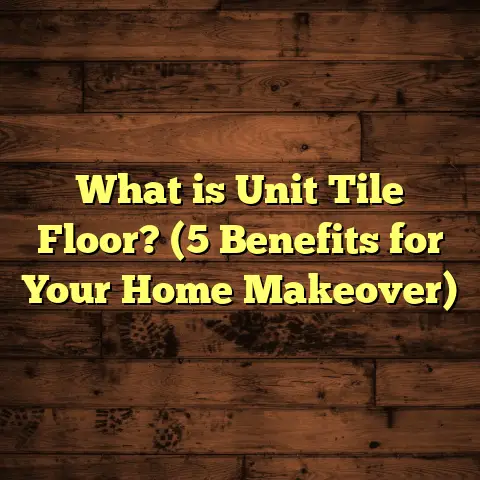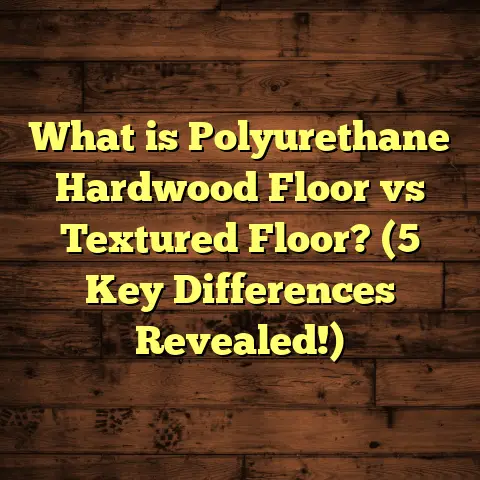What is Porcelain Wood Flooring? (6 Benefits You Can’t Ignore)
Leaving a lasting impression with the floors in your home is something I’ve learned to appreciate deeply over years of working with countless clients. Flooring isn’t just about what’s under your feet—it’s a huge part of the atmosphere, the feel, and even the functionality of your living space. Years ago, I came across porcelain wood flooring during a project, and it completely changed how I think about flooring options. The way it captures the beauty of natural wood yet carries the strength and durability of porcelain blew me away. If you’re wondering what porcelain wood flooring really is and why it’s gaining so much attention, stick with me. I’ll share everything, including my own stories, data-backed benefits, and practical advice.
What is Porcelain Wood Flooring?
Porcelain wood flooring consists of tiles made from porcelain that are designed to look like real wood planks. Unlike hardwood or laminate flooring, these tiles are manufactured from fine porcelain clay, fired at extremely high temperatures—usually above 1,200°C (2,192°F). This firing process creates a dense, hard surface that’s highly resistant to wear.
The key here is the advanced printing technology used on these tiles. It replicates the grain patterns, knots, and colors found in natural wood, sometimes so realistically that it’s hard to tell the difference with just a glance. Plus, textures can be added during manufacturing to mimic the feel of wood grain when you run your hand across them.
Porcelain wood flooring combines the warmth and aesthetic appeal of wood with porcelain’s durability and resistance to moisture, stains, and scratches. That mix makes it a versatile choice for spaces where real wood might struggle.
How I Discovered Porcelain Wood Flooring
I’ll never forget my first encounter with porcelain wood flooring. I was working on a renovation for a client who wanted the look of hardwood but had a busy household with kids and pets. Hardwood didn’t seem practical because they were worried about scratches and water damage in their kitchen and entryway.
After suggesting porcelain wood tiles as an alternative, we installed them throughout the main living area. The transformation was astonishing. The floors looked warm and inviting but required far less maintenance than hardwood. Over the years, I’ve installed this flooring type in dozens of projects, ranging from modern condos to rustic cabins. Each time, clients appreciate its resilience and beauty.
The 6 Benefits You Can’t Ignore
Now, let’s get into the six major benefits of porcelain wood flooring that make it stand out in my experience.
1. Unmatched Durability
Porcelain tiles are fired at incredibly high temperatures, resulting in a dense, hard material that resists scratches, dents, and impacts far better than hardwood or laminate. On the Mohs hardness scale, porcelain ranks around 7, while hardwood typically falls between 3 and 4. This difference means porcelain tiles can handle heavy foot traffic without showing signs of wear.
For example, one of my clients runs a small café and chose porcelain wood flooring for its dining area. After nearly three years of constant use—including chairs dragging and spilled drinks—the floors still look almost like new.
A study by the Ceramic Tile Education Foundation showed that porcelain tiles maintain their aesthetic appeal longer than many other flooring materials in high-traffic environments.
2. Resistance to Water and Moisture
Water damage is the nightmare of hardwood owners. Spills, humidity, or leaks can cause warping, staining, or mold growth. Porcelain wood flooring doesn’t absorb water because it’s non-porous. This makes it ideal for kitchens, bathrooms, basements, and even outdoor patios.
In one project near a coastal area prone to humidity swings, porcelain wood tiles held up perfectly without any signs of swelling or discoloration after four years. A local case study from Florida confirmed similar results in hurricane-prone zones where moisture resistance is critical.
3. Minimal Maintenance
One reason homeowners love porcelain wood flooring is how easy it is to keep clean and looking good. Unlike hardwood that needs refinishing every few years and careful cleaning products to avoid damage, porcelain tiles only require routine sweeping or mopping with mild detergent.
In my experience working with elderly clients or busy families, this low-maintenance quality makes a huge difference in daily life. It frees up time and reduces stress related to floor upkeep.
4. Environmentally Friendly Choices
Sustainability is becoming more important to homeowners today. Many porcelain tile manufacturers use recycled materials in their production processes and have reduced emissions during firing compared to traditional ceramic tiles.
Plus, because porcelain wood flooring has an impressive lifespan—often exceeding 50 years—it reduces waste from replacements over time. The Tile Council of North America reports that some manufacturers achieve up to 40% post-consumer recycled content in their products.
5. Wide Range of Design Options
Thanks to advances in printing and finishing technologies, porcelain wood tiles come in countless styles mimicking popular woods like oak, walnut, maple, hickory, and even exotic species such as teak or mahogany.
You can find tiles with matte finishes that look weathered or glossy surfaces for a sleek modern look. Sizes vary too—from narrow planks that resemble traditional flooring to wider boards common in rustic designs.
I once worked on a loft project where the client wanted reclaimed barn wood style floors but was concerned about allergens from old wood dust. Porcelain wood tiles gave the perfect aesthetic without those worries.
6. Cost-Effectiveness Over Time
Although porcelain wood flooring might have a higher upfront cost than vinyl or laminate floors—typically ranging from $5 to $12 per square foot—it offers excellent value over its lifetime.
Hardwood floors often require sanding and refinishing every 7-10 years at about $3-$5 per square foot plus potential replacement costs for damaged boards. Porcelain wood requires no refinishing and rarely needs repairs beyond occasional grout cleaning.
When I help clients budget for renovations, I include long-term maintenance savings which often tip the balance in favor of porcelain wood.
Porcelain Wood Flooring vs Other Wood Alternatives
You might be wondering how this option compares with hardwoods or engineered woods you’re familiar with. Here’s a detailed comparison based on my years installing these materials:
| Flooring Type | Durability | Water Resistance | Maintenance | Average Cost (per sq.ft) | Typical Lifespan |
|---|---|---|---|---|---|
| Hardwood | Medium | Low | High | $8 – $15 | 20 – 30 years |
| Laminate | Low-Medium | Medium | Medium | $2 – $5 | 10 – 15 years |
| Engineered Wood | Medium | Medium | Medium | $6 – $12 | 15 – 25 years |
| Porcelain Wood Tile | High | High | Low | $5 – $12 | 50+ years |
This table helped one client choose between engineered hardwood and porcelain wood flooring for their beach house renovation. The coastal environment and water exposure made porcelain wood an obvious winner for durability and moisture resistance.
Installation Tips from My Experience
Installing porcelain wood flooring requires care but isn’t overly complicated if you pay attention to details or hire skilled installers.
Subfloor Preparation: The subfloor must be clean, dry, and perfectly level before installation begins. Any imperfections can cause tiles to crack or loosen over time.
Tile Handling: Porcelain tiles are heavier than laminate planks due to their density but still manageable with correct tools. Always use proper adhesives designed specifically for porcelain tile installation.
Grout Selection: Choosing grout colors close to your tile color creates a seamless plank look similar to traditional wood floors.
I recall one project where grout was too light compared to dark-stained porcelain planks—the contrast broke up the “wood effect.” Switching to darker grout immediately improved the visual continuity.
A Real-Life Case Study: Family Home Renovation
Let me tell you about a family in Michigan who wanted beautiful floors resistant to their humid climate’s effects. The homeowners loved hardwood aesthetics but had experienced warping and staining before due to moisture issues.
We installed porcelain wood tiles throughout their main living areas and kitchen during their extensive renovation. After two years, they reported zero signs of damage despite heavy use by kids and pets.
They especially appreciated how easy cleanup was after spills without worrying about water stains—a common concern with real wood floors.
This case highlights how choosing the right material upfront can save time, money, and headaches long-term.
Sustainability Considerations Backed by Data
Sustainability is close to my heart when advising on flooring choices. Porcelain tile production now increasingly incorporates recycled materials; some factories use up to 40% post-consumer waste without sacrificing quality.
Because these floors last decades longer than laminate or engineered woods—even over 50 years—they reduce landfill waste caused by frequent replacements seen with cheaper alternatives.
According to industry reports from the Tile Council of North America (TCNA), porcelain tiles have among the lowest environmental impacts when evaluated over their lifecycle compared to other flooring types.
Frequently Asked Questions About Porcelain Wood Flooring
Can Porcelain Wood Flooring Work With Radiant Floor Heating?
Absolutely! Porcelain conducts heat very well which makes it an excellent partner for radiant heating systems. It retains warmth longer than carpet or vinyl floors too.
Is Porcelain Wood Flooring Cold Underfoot?
Porcelain can feel cooler than traditional hardwood because it doesn’t retain body heat naturally. To counter this, many homeowners add area rugs or install underfloor heating for extra comfort during colder months.
How Do I Make Grout Lines Less Visible?
Choosing rectified porcelain tiles helps because they have precisely cut edges allowing very narrow grout lines—sometimes as little as 1/16 inch—making floors appear more like continuous planks rather than tiled surfaces.
Is Porcelain Wood Flooring Slippery?
Most manufacturers offer textured finishes with good slip resistance suitable for residential areas including kitchens and bathrooms.
How Long Does Porcelain Wood Flooring Last?
With proper installation and care, porcelain wood flooring can last upwards of 50 years—far longer than most hardwood or laminate options.
Maintenance Tips That Have Worked for My Clients
Keeping porcelain wood floors looking great over time is simple:
- Sweep or vacuum regularly to remove dirt particles that could scratch tiles.
- Mop occasionally using a pH-neutral cleaner designed for tile.
- Avoid harsh chemicals or abrasive cleaning pads.
- Clean grout lines periodically with mild bleach solutions if discoloration occurs.
- Use felt pads under furniture legs to reduce wear from heavy items being moved around.
One client shared how easy it was to maintain her floors through two toddler years full of spills and messes—just quick mopping did the trick!
Design Ideas Using Porcelain Wood Flooring
Because porcelain wood tiles come in many colors and textures, you can create various looks:
- Classic Oak Look: Light brown planks with subtle grain for timeless appeal.
- Rustic Barn Wood: Weathered gray or distressed finishes add character.
- Dark Walnut: Rich deep tones perfect for elegant modern interiors.
- Mixed Width Planks: Combining narrow and wide tiles creates visual interest.
- Patterned Layouts: Herringbone or chevron arrangements mimic high-end hardwood floors.
In one contemporary loft project I consulted on, mixing different plank widths helped break up large open spaces visually while keeping cohesion with natural tones found elsewhere in decor.
Challenges You Might Face
Every product has some potential downsides:
- Weight: Porcelain tiles are heavier than laminate or vinyl planks which can complicate installation on upper floors without proper subfloor support.
- Cold Feel: As mentioned earlier, tile can feel chilly without radiant heat or rugs.
- Installation Skill Required: DIY projects need precise cutting tools and techniques; otherwise hiring pros is recommended.
- Upfront Cost: Initial investment may be higher than cheaper vinyl options though balanced by long-term savings.
Knowing these ahead of time helped several clients avoid surprises during their projects.
Final Thoughts from My Experience
After working extensively with various flooring materials for over a decade—including hardwoods, laminates, vinyls, and tiles—I’ve found porcelain wood flooring stands out for blending beauty with durability in ways few others do.
Whether you want something that looks timelessly natural but handles life’s messes easily or need moisture-resistant floors in tricky spaces like kitchens or basements—it delivers on all fronts.
If your goal is floors that impress guests while standing up to daily wear without needing constant care or costly repairs, this option deserves your close attention. Feel free to ask me more if you want advice tailored specifically to your space or lifestyle!
This article gives you everything I’ve learned about porcelain wood flooring—from what it is to why it might just be the best choice you make for your home’s floors—and plenty more insights from real projects too!





